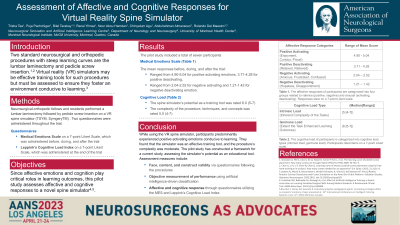Assessment of Affective and Cognitive Responses for Virtual Reality Spine Simulator
Friday, April 21, 2023


Trisha Tee (she/her/hers)
Student Researcher
McGill University: Neurosurgical Simulation and Artificial Intelligence Learning Centre
ePoster Presenter(s)
Introduction: Two standard neurosurgical and orthopedic procedures with steep learning curves are the lumbar laminectomy and pedicle screw insertion. Virtual reality (VR) simulators may be effective training tools for such procedures but must be assessed to ensure that they foster an environment that is conducive to learning. Since affective emotions and cognition play critical roles in learning outcomes, this pilot study assesses affective and cognitive responses to a spine simulator.
Methods: Neurosurgical-orthopedic fellows and residents performed a lumbar laminectomy followed by pedicle screw insertion on a VR spine simulator (TSYM, SymgeryTM). Before, during, and after the trial, participants completed questionnaires that utilized the Medical Emotions Scale and the Leppink’s Cognitive Load Index on 7-point Likert scales. Affective responses were categorized as positive activating (enjoyment, proud, curious), positive deactivating (relaxed, relieved), negative activating (anxious, frustrated, confused), and negative deactivating (hopeless, disappointment) emotions.
Results: Seven individuals participated in the study. The mean scores of affective responses before, during and after the trial remained in the range of 4.90-5.04 for positive activating emotions, 3.71-4.28 for positive deactivating, 2.04-2.52 for negative activating and 1.21-1.42 for negative deactivating emotions. Regarding cognitive load, the spine simulator’s potential as a training tool was rated (median[range]) as 6.0 (5-7), and the complexity of the procedure, techniques and concepts were rated as 5.0 (4-7).
Conclusion : While using the VR spine simulator, participants predominantly experienced positive activating emotions, which are conducive to learning. They also found that the simulator was an effective training tool, and the procedure’s complexity was moderate. The pilot study has constructed a framework for a current study that is assessing the simulator’s potential as an educational tool. Affective and cognitive response questionnaires as well as artificial intelligence-driven classification for objectively measuring performance are being used to provide a greater understanding of the simulator’s educational utility.
Methods: Neurosurgical-orthopedic fellows and residents performed a lumbar laminectomy followed by pedicle screw insertion on a VR spine simulator (TSYM, SymgeryTM). Before, during, and after the trial, participants completed questionnaires that utilized the Medical Emotions Scale and the Leppink’s Cognitive Load Index on 7-point Likert scales. Affective responses were categorized as positive activating (enjoyment, proud, curious), positive deactivating (relaxed, relieved), negative activating (anxious, frustrated, confused), and negative deactivating (hopeless, disappointment) emotions.
Results: Seven individuals participated in the study. The mean scores of affective responses before, during and after the trial remained in the range of 4.90-5.04 for positive activating emotions, 3.71-4.28 for positive deactivating, 2.04-2.52 for negative activating and 1.21-1.42 for negative deactivating emotions. Regarding cognitive load, the spine simulator’s potential as a training tool was rated (median[range]) as 6.0 (5-7), and the complexity of the procedure, techniques and concepts were rated as 5.0 (4-7).
Conclusion : While using the VR spine simulator, participants predominantly experienced positive activating emotions, which are conducive to learning. They also found that the simulator was an effective training tool, and the procedure’s complexity was moderate. The pilot study has constructed a framework for a current study that is assessing the simulator’s potential as an educational tool. Affective and cognitive response questionnaires as well as artificial intelligence-driven classification for objectively measuring performance are being used to provide a greater understanding of the simulator’s educational utility.
